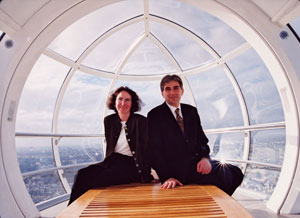Eleanor Harris: Inspiration for British Airways i360
A question we are often asked is: “what was the inspiration for British Airways i360?” Our story began in 2000 when the London Eye opened to huge critical acclaim and quickly became the UK’s most visited paid-for visitor attraction; a record it still holds 16 years later.
Its architects, husband and wife team David Marks and Julia Barfield from Marks Barfield Architects, were approached by countless cities who wanted an ‘Eye’ but found that a similar wheel design would not be financially viable without a suitable site and sufficient visitor numbers. Smaller wheels don’t provide anything like the same experience as you are at a similar height as the buildings around you and so don’t enjoy sweeping views.

They realised that what sets the London Eye apart from traditional observation towers is the way that the view gradually unfolds on the Eye (instead of going up in an internal lift and then stepping out on to a viewing platform) and it is this ‘flight’ like experience that visitors love. So the architects went back to the drawing board and designed the i360, which replicates the same gradual flight experience rising to a great height.
The i360 uses incredibly innovative engineering: it will be the world’s first vertical cable car where passengers can walk around freely inside the moving viewing pod. We think the experience will be even better than the London Eye as the glass viewing pod is 10 times the size of a London Eye capsule with a Sky Bar making it a fantastic shared group experience.
The design also means we can have a large building at the base of the tower with dining, hospitality, exhibition and children’s play facilities, making British Airways i360 much more than just a viewing tower.
I too have been part of this story from the outset, as I have worked with David and Julia since 2000, first at the London Eye and since 2006 on the i360 when we applied for our planning consent. It will be a very proud moment for us when it opens this summer.




















